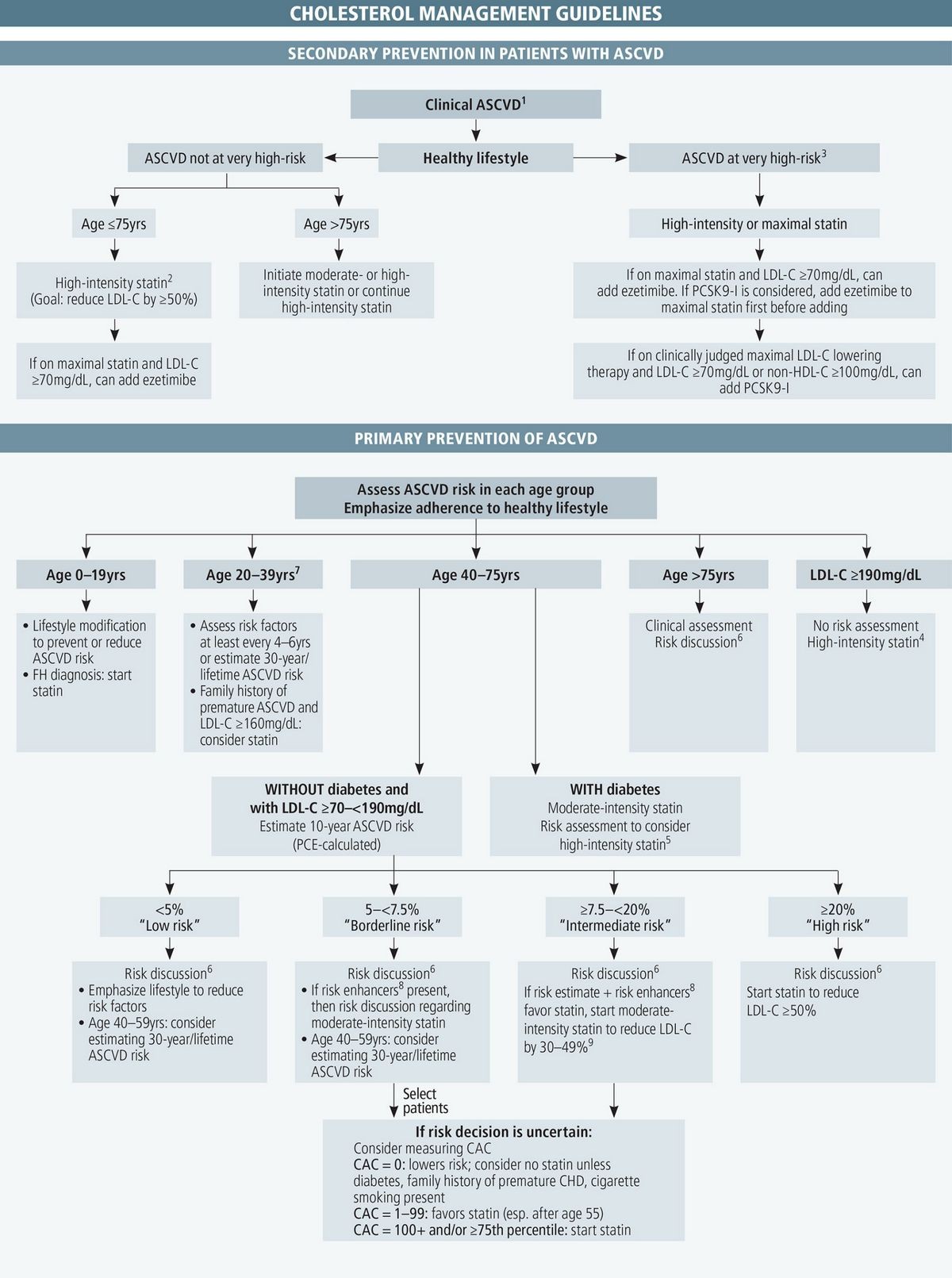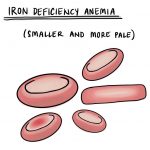
Cholesterol Guidelines for Adults (2001)
Men and women 20 years and older should undergo cholesterol screening every 5 years. Blood samples should be obtained after fasting and should be tested for total cholesterol, LDL cholesterol, HDL cholesterol, and triglycerides.
LDL cholesterol is the bad cholesterol because high blood LDL levels increase the risk of CHD. HDL cholesterol is the good cholesterol because low HDL levels increase the risk of CHD while high HDL levels help protect a person from developing CHD. High levels of triglycerides are also believed to increase the risk of CHD.
100-129 Near or above optimal
130-159 Borderline high
160-189 High
> 190 Very high
Total cholesterol (mg/dl)
150-199 Borderline-high
200-499 High
>500 Very high
Elevated LDL cholesterol is a major cause of CHD. Lowering LDL cholesterol by diet and medications has been shown in numerous clinical trials to significantly reduce the risk of CHD (such as heart attacks and strokes). Therefore, lowering LDL cholesterol is the first priority in preventing CHD.
The CHD risk calculation is based on a scoring system that grew out of the Framingham Heart Study. A person’s risk (chance) of developing CHD in the next 10 years is calculated based on the cholesterol level as well as other non-cholesterol risk factors. The non-cholesterol risk factors are classified as highest risk factors, major risk factors, and other risk factors.
The highest risk factors include:
- Diabetes mellitus
- Having already developed CHD, as evidenced by a prior heart attack, bypass surgery, etc.
- Having already developed arteriosclerosis (hardening and narrowing) in arteries other than the heart. Arteriosclerosis in the other arteries can lead to poor circulation in the lower extremities, aneurysm of the abdominal aorta, and stroke.
The major risk factors include:
- Men over 45 years and women over 55 years
- Cigarette-smoking
- High blood pressure (BP >140/90 mmHg or taking high blood pressure medications)
- HDL cholesterol
- Having first-degree male relatives with CHD (such as a heart attack) before age 55 years and first-degree female relatives with CHD before age 65 years.
Individuals with any one of the highest risk factors have the highest CHD risk. More than 20 out of 100 in this group will develop CHD or a recurrent CHD event such as a heart attack within 10 years (i.e., they have a 10-year CHD risk of >20%).
Individuals with 0-1 major risk factors usually have 10-year CHD risk of
Individuals with 2 or more of the major risk factors can have 10-year CHD risks of 20%.
Other risk factors include obesity, high saturated fat and high cholesterol diet, sedentary lifestyle, and elevated homocysteine and lipoprotein(a) levels. Even though these risk factors were not used in the Framingham risk score calculation, they are recognized risk factors for CHD.
QUESTION
The target (goal) level of LDL cholesterol depends on the person’s CHD risk. Individuals with high CHD risks should strive for lower LDL cholesterol target levels than those with lower CHD risks. Thus, individuals who have diabetes or prior heart attacks or strokes should strive for LDL cholesterol below 100 mg/dl. Individuals who have 2 or more risk factors, but without diabetes or CHD, can have an LDL target of
| Risk Category | LDL cholesterol Goal (mg/dl) |
| Have CHD and/or diabetes,10-year risk >20% | |
| 2 or more risk factors,10-year risk | |
| 0-1 risk factor, 10-year risk |
Therapeutic Lifestyle Change (TLC) is a comprehensive program involving diet, weight reduction, and exercise to reduce the risk for CHD.
Therapeutic Lifestyle Change (TLC) Diet
| Nutrient | Recommended Intake | Comments |
| Saturated fat | Lowering intake of saturated fat help lower LDL levels | |
| Polyunsaturated fat | Up to 10% of total calories | Unsaturated fat may help decrease triglycerides and increase HDL levels |
| Monounsaturated fat | Up to 20% of total calories | Unsaturated fat may help decrease triglycerides and increase HDL levels |
| Total fat | 25%-35% of total calories | Try to keep saturated fat and trans fatty acids low, unsaturated fats high |
| Carbohydrates | 50%-60% of total calories | |
| Fiber | 20-30 grams/d | |
| Protein | Approximately 15% of total calories | |
| Cholesterol | Lowering intake of cholesterol help reduce LDL levels | |
| Total calories | Balance intake to maintain desirable weight and prevent weight gain | Moderate exercise and weight reduction not only help to reduce LDL but also reduce other risk factors associated with the metabolic syndrome |
| Soluble fiber | 10-25 g | Soluble fiber help lower blood cholesterol |
Therapeutic Lifestyle Change (TLC) recommendations are based on the LDL cholesterol levels and the CHD risks. Individuals with high CHD risks should be started on TLC at lower LDL cholesterol levels than people with lower risks of CHD.
| Risk Category | LDL Goal (mg/dl) | LDL level at which to initiate TLC |
| Have CHD and/or diabetes,10-year risk >20% | >100 | |
| 2 or more risk factors, 10-year risk 10%-20% | >130 | |
| 2 or more risk factors, 10-year risk | >130 | |
| 0-1 risk factor,10-yearrisk | >160 |
Lipid-lowering medications are used in addition to TLC to lower LDL cholesterol to target levels. Examples include:
1) Patients with CHD (prior heart attacks, strokes, bypass surgery, or angioplasty) or diabetes can greatly reduce their risk of future heart attacks or strokes by aggressively lowering LDL cholesterol. Thus, many patients are given LDL-lowering medications simultaneously with TLC to attain LDL cholesterol of below 100 mg/dl.
2) Patients who have been hospitalized for heart attack, angioplasty, or bypass surgery should be discharged on a LDL lowering medication in addition to TLC if the LDL cholesterol is >130 mg/dl. Some experts recommend LDL-lowering medications even if the LDL is 100-129 mg/dl.
3) Patients with no strokes, heart attacks, or other known CHD should also be considered for LDL-lowering medications if TLC is not successful in bringing LDL cholesterol down to target levels.
| Risk Category | LDL Goal (mg/dl) | LDL level at which to initiate TLC | LDL level at which to consider LDL lowering medications |
| Have CHD and/or diabetes,10-year risk >20% | >100 | >130, (although some experts recommend medications if LDL between 100-129) | |
| 2 or more risk factors, 10-year risk 10%-20% | > 130 | >130 | |
| 2 or more risk factors, 10-year risk | >130 | >160 | |
| 0-1 risk factor,10-year risk | >160 | >190, (medications optional for LDL 160-189) |
Statins are the most extensively studied and widely used LDL-lowering medications. Numerous large scale, long term trials have shown that statins and diet can reduce the risk of heart attacks and strokes in people with or without CHD. Other lipid-lowering agents include nicotinic acid, fibrates such as Lopid, and bile acid sequestrants such as Questran. Please refer to the Heart Attack Prevention forum on MedicineNet.com for an in-depth discussion of cholesterol management.
Metabolic syndrome is a collection of risk factors. Metabolic syndrome is characterized by physical inactivity, abdominal obesity (male waist >40" and female waist >35"), high blood pressure, insulin resistance (impaired normal action of insulin), low HDL cholesterol (men
Evidence is accumulating that the CHD risk can be further reduced beyond LDL cholesterol-lowering by treating the various aspects of the metabolic syndrome.
The treatment of metabolic syndrome involves weight reduction and exercise. Weight reduction and regular exercise decrease insulin resistance, increase HDL cholesterol, decrease triglycerides, and lower blood pressure.
Please refer to the Heart Attack Prevention forum of Medicinenet.com for further discussion on the treatment of high triglycerides and low HDL, as well as a review of the role of aspirin, B vitamins, and ACE inhibitors in the prevention of heart attack.
Management Of High Blood Cholesterol In Adults At A Glance
- Men and women 20 years and older should undergo cholesterol screening every 5 years. Blood samples should be obtained after fasting and should be tested for total cholesterol, LDL cholesterol, HDL cholesterol, and triglycerides.
- Lowering LDL cholesterol by diet and medications is a first priority in reducing the risk of coronary heart disease (CHD).
- The risk for developing coronary heart disease can be estimated by using the cholesterol blood levels.
- The target (goal) level of LDL cholesterol depends on the person’s CHD risk.
- Lipid-lowering medications are used in addition to lifestyle changes to lower LDL cholesterol to target levels.
By clicking "Submit," I agree to the MedicineNet Terms and Conditions and Privacy Policy. I also agree to receive emails from MedicineNet and I understand that I may opt out of MedicineNet subscriptions at any time.
By clicking "Submit," I agree to the MedicineNet Terms and Conditions and Privacy Policy. I also agree to receive emails from MedicineNet and I understand that I may opt out of MedicineNet subscriptions at any time.

